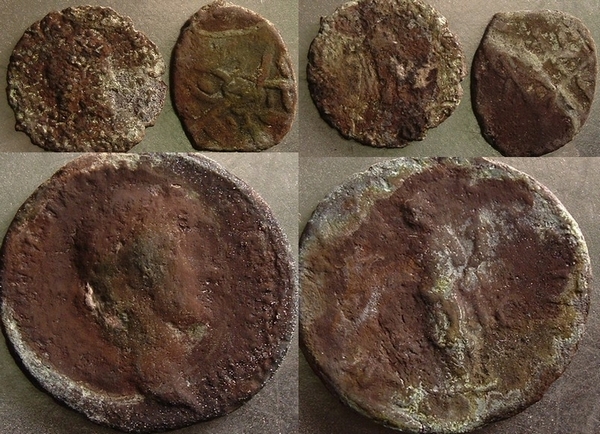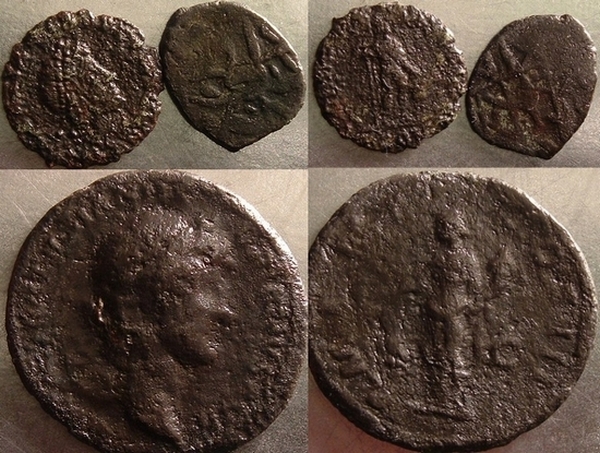JAX PROCEDURE for Troy
This is for Troy, so he has an idea of what Jax will do.
My procedure is this:
After a soak in rubbing alcohol, I used my 3M radial brushes, then wiped them with the micro fiber cloth.
Here's 3 coins- two are from my English cull lot and the other one has been tooled.

These are cleaned down to bare metal, the odd little coin in the bottom right has some patina left, but not much. Darn ol' Englsih coins- that's one of the dangers with them- not having good solid patinas, but you can definitely find interesting coins. The top right coin is severely porous (also common in my experience with English coins). I received the large coin in a reject lot from Kevin, who had partially tooled it. The coins are shinier than they appear.
Next, I put the coins in a small plastic container, and put a couple ounces of Jax in. I swirled the container after 10 seconds or so, and left the coins in for about 20 seconds total. I let them air dry for about 30 minutes, then repeated. I then let the coins sit overnight before touching them again. This allows the chemical to adhere and set.
As I expected, the tooled coin needed another application this morning. For some reason, the Jax doesn't cover tooled coins very well. I let it sit for 8 hours or so, before touching it.
I should note that the coins should sit to set- and you should handle them by the rim and try not to touch the coin. The finish will come off rather easily. Also, you should always wash your hands afterwards, to remove any chemical that you got on your fingers. It's supposed to be toxic to humans- so don't drink it! It doesn't burn or anything, but might be something that could be absorbed through your skin. So some precautions should be taken.
Here's what I have, after the chemcal has set.

Next, I applied Renwax. I differ from most people, and apply with my finger. Do this gently- or you'll rub the finish off. Some will come off no matter how gently you do this.
I then use a soft horse hair wheel to buff the Renwax (another procedure that differs from most). Here's what we have as an ending result:

Brown Jax was used for this.
If you like the brown or green, I suggest:
If you like brown/black or black, then I suggest Kevin at
The porousness of the top right coin has been diminished, and the coins are no longer shiny bare metal. This improves the look of the coins, and will help prevent BD.
NOTE:
When a procedure such is this is used; the moral and honest thing to do is list that the coin has been tooled, repatinaed- whatever.
Most people frown upon repatination- mainly due to the dishonest people who fail to list that the coin was repatinaed.
I know that if I paid $200 for a coin, that I thought was "original", and received a repatinaed or tooled coin- I would be miffed. Even though I don't intend to sell any of my coins, at least in the near future, I make sure that I label them if I used any non-traditional techniques, such as repatination.
So please, be honest and label your repatinaed coins.
I repatina mostly because I don't like the look of bare metal- but sometimes it is unavoidable to yield bare-metal coins.
UPDATE 4/15/06
I did a little experimenting with an idea I had while sitting out on the back deck.
I jaxed some zapped coins 5 days ago, and remembered them today.
They had been jaxed my usual way- soak in Jax for 15-30 seconds, drain, let dry for 15-30 minutes, repeat. This time they sat out for 5 days.
I used the micro fiber cloth on them, to remove the powdery residue, which I normally just leave on. I used very little pressure, and just wiped the coins. Even though I used brown Jax, after Renwaxing, most came out with more of a blackish color to them. The colors vary between brown and black, with some hints of green on some of them.
I also tried my soft horse hair wheel at around 5k rpm- this worked well as well. I like power tools, so I'll probably use this from now on.
Don't use too much pressure, or you'll remove Jax from highpoints, though I only lost Jax with the cloth, not the wheel.
Details are more evident, and the surface is more smooth than when I didn't remove the Jax residue.
I'm really liking the outcome with this step.
Some of the coins that I Jaxed:
You can see some of the bare metal on high points- I was using too much pressure with the cloth. With the wheel, I just let the wheel glode across the surface- no pressure at all. These aren't pretty coins by any means, but were completely unattributable before zapping. Most have metal spurring, even that little Theodosius II campgate. At least they're attributable now.
If you look at coins, such as the Probus and VOT, the surface itself seems smoother. Both of these coins were rather porous before Jaxing.